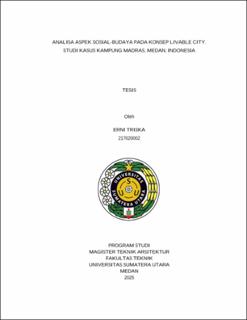Analisa Aspek Sosial-Budaya pada Konsep Livable City. Studi Kasus Kampung Madras, Medan, Indonesia
Analyzing Social-Cultural Aspect Based on Livable City. Case Study Kampung Madras, Medan, Indonesia

Date
2025Author
Triska, Erni
Advisor(s)
Ginting, Salmina Wati
Mardianta, Anthoni Veery
Metadata
Show full item recordAbstract
"Livable cities" is a concept that refers to the quality of life in a city that allows its residents to live comfortably, safely, healthily, and productively, or in other words, 'alive.' This concept includes various dimensions of environmental quality, ranging from physical, social, and cultural environments. In terms of the physical environment, indicators such as air and noise pollution, water quality, public facilities (schools, hospitals, parks, public spaces, etc.), and infrastructure (roads, terminals, airports, etc.) are assessed. Additionally, the socio-cultural environment, which refers to how city residents interact and socialize, is also an important indicator. Despite having the potential to become a safe and comfortable city, based on the Most Livable City Index surveys of 2017 and 2022, Medan City is considered not livable, especially in the social and cultural aspects. This has led to the conduct of this study, which aims to explain the socio-cultural aspects that contribute to a livable city. The Madras Village area, or Little India, was chosen as a case study, given that this area is rich in socio-cultural potential, including historical buildings and cultural festivals. Data was collected through field observation, interviews, and the distribution of questionnaires. The data was then analyzed by mapping historical buildings and cultural activities on ten streets in Madras Village. The analysis was based on variables such as the number of historical buildings, regulations for the protection of historical buildings, area identity, community participation, the availability of public spaces, and art and cultural attractions. The results of the study show that K.H. Zainul Arifin Street has the highest livability level, followed by Teuku Cik Ditiro Street, Kejaksaan Street, and Teuku Umar Street. However, when assessed overall, Madras Village is considered less livable.
Collections
- Master Theses [260]
